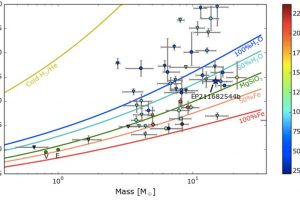A sub-Neptunian planet discovered around a G9 star. Published on MNRAS: “K2-263 b: a 50 d period sub-Neptune with a mass measurement using HARPS-N” of A. Mortier (University of St. Andrews)

The search of exoplanets relies mainly on two techniques: transits and radial velocity. With the former method exoplanets are revealed thanks to small and periodic dimming of the light of stars when their planets orbit across the stellar disk, producing a small eclipse. The method of radial velocity consists in revealing the oscillations of stars around the center of mass in common with their planetary system, using high resolution spectroscopic observations.
If the properties of the central star are known, these techniques provide different hints on the nature of exoplanets. Transits, in fact, reveal the size of planets together with information on their orbits. Radial velocities, instead, allow us to estimate the mass of the planets. Used together, then, these methods allow to estimate the bulk density of the planets and understand whether they are small rocky planets like Earth or gas giants like Jupiter.
This is the analysis adopted in the study “K2-263 b: a 50 d period sub-Neptune with a mass measurement using HARPS-N” of A. Mortier (Centre for Exoplanet Science, University of St. Andrews) to characterise the planet discovered around the G9 star EPIC211682544. This planet has been discovered with the method of transits by the NASA satellite Kepler during its extended K2 mission. These observations allowed to estimate its orbit period (50.8190±0.0001 days) and radius (2.4±0.1 Earth radii). The planet has also been observed with HARPS-N mounted on the Telescopio Nazionale Galileo, which is one of the most important existing instruments to characterise planets with the method of radial velocity. By analysing 67 high resolution spectra of this planet and star, the authors of the study estimated the mass of the planet (14.8±3.1 Earth masses) obtaining a bulk density of about 5.7 g cm−3. Thus, this planet can be classified as a sub-Neptunian planet, with a composition in between from that of rocky planet (32.5% Fe/Ni metals + 67.5% Mg-silicates-rocks) and a pure 100% water planet. The study is published on the Monthy Notices of the Royal Astronomical Society with the collaboration of the astronomers of the Astronomical Observatory of Palermo L. Affer and G. Micela.
The figure (link) shows the radius vs. mass distribution of known planets with reliable measurements, with information of their temperature and composition.
of Mario Giuseppe Guarcello ( follow mguarce)
